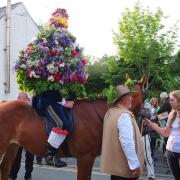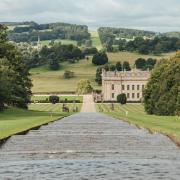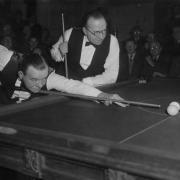Derbyshire’s long mining heritage has led to many stories and interpretations over the centuries. Some are rousing, some superstitious in nature, whilst others are poignant and tragic, as Richard Bradley discovers
Over the course of thousands of years, generations of Derbyshire folk have been employed in the mining industry, burrowing deep into the landscape and extracting the mineral riches within.
Employees in both the lead and coal mining industries worked underground against the constant backdrop of danger – illustrated by examples within my own family.
My grandad, Joe Bradley (who took over as union treasurer at Glapwell Colliery when the previous incumbent – one Dennis Skinner - left in 1970 for the House of Commons), permanently lost use of his right arm in the 1940s after getting it caught and wound into a colliery conveyor belt.
His sister Alice’s husband, Lucjam Plewinski, a Polish refugee who arrived after the Second World War, met a worse fate; one of 18 killed in the 1973 Markham Pit disaster, where a lift carrying miners malfunctioned and plunged from the surface down to the mine workings.
Given the perpetual hazards, it’s unsurprising a number of superstitions and folklore developed around the mining industry.
Lead has been mined in Derbyshire since at least Roman, potentially prehistoric, times. Disputes were settled by the Great Barmote Courts for the High Peak and Low Peak. Their regulations were passed into law in 1288 but likely existed in less formal guises beforehand.
Miners were granted certain entitlements, including right of way to access the lead veins they were prospecting – many former miners’ paths remain as public footpaths crisscrossing the White Peak to this day.
A negligible amount of lead mining activity takes place nowadays, but the court still sits ceremonially every year at Wirksworth’s Moot Hall, usually on the third Wednesday in April. The public are welcome to observe proceedings.
Another Barmote Court is held behind closed doors at Chatsworth in the autumn. Before the court sits, a traditional meal of bread, cheese and ale is provided, a hangover from when lead miners would walk miles over the moors to attend and required sustenance.
Previously clay pipes inscribed with jury members’ names were smoked too; some examples can be seen at the Wonders of the Peak gallery at Buxton Museum.

Another annual observance in the Wirksworth area was The Miners' Holiday, described in an 1863 guidebook, Wirksworth and Five Miles Round, as ‘a day set apart for the miners for festivity. It is observed on the thirteenth of May… In these festivities they are joined frequently by the proprietors of the mines in which they are employed, music often enlivens the proceedings, and old songs, peculiar to the miners, are well and heartily sung’.
Whistling down the mine was thought bad luck and strictly forbidden. Mining historian Nellie Kirkham spoke to a lead miner at Mill Close Mine, South Darley, who made this mistake as a new recruit in the 1950s and was threatened by an older colleague wielding a hammer.

Miners often thought that when working underground they were not alone and were sharing their workspace with various supernatural presences. One was T’Owd Man. Opinion differed as to what it represented – it could be used to represent the lead ore itself; the tangible previous generations of their former colleagues - or their ghostly spirits which lingered.
A Saxon era carving embedded in the wall of Wirksworth church known as T’Owd Man is thought to be the oldest image of a miner in the world, although he was originally located in the church at Bonsall.
A custom on Christmas Eve was to leave a candle burning for T'Owd Man on a good quality piece of ore left within in the mine for luck, recorded as having taken place in Castleton, Bradwell and Mill Close Mine.
This ritual has been upheld since the 1970s by mining enthusiasts responsible for the upkeep of the Goodluck Mine near Middleton-by-Wirksworth. The custom is also maintained at Temple Mine, Matlock Bath, owned by the Peak District Mines Historical Society.
Coal miners also had their traditions and superstitions. The indefatigable Victorian folkorist Sidney Oldall Addy recorded in his 1895 Household Tales, ‘Colliers in the north of Derbyshire leave a hundredweight of coal in the pit every week for the fairies’.
Even Derbyshire’s best-known annual tradition, well dressing, commented on the conditions miners faced. In 1938, well dressers of Barlow eschewed the usual biblical scenes to construct a hard-hitting floral tableaux, The Price of Coal, in response to a tragedy earlier that year at Markham Colliery, eight miles away.
As mentioned, Markham suffered further tragedy in 1973. A recent sculptural installation near the former site, Walking Together, remembers each miner killed in these disasters as well as a previous 1937 explosion.
L.J. Rodgers, a University of Leeds student, observed the folk life of one North East Derbyshire mining community for their 1967 thesis Holmewood – portrait of a village: a survey of the customs, traditions and beliefs in a Derbyshire mining village, including, ‘It is unlucky if a “coffin” is shot from the fire. A “coffin” is a piece of coke or cinder which is concave – of the rough shape of a coffin’ and hence this occurrence was equated to portend a forthcoming ‘sign of death’.
It was also thought bad luck for a father and son to work together in the same district of the mine, and if a miner set off for work and discovered he had left something behind (for example his ‘snap’ – lunchbox), it was considered bad luck to go back and retrieve it.
Rodgers sets these superstitions in the context of the constant presence of danger: ‘there is a minority of people who believe strongly in superstitions… Most of the old women who are strongly superstitious are widows, who live alone and are frightened. Fear breeds superstition, as is indicated in the case of these old women and of the old miners, who, to some extent, still live in the times when the whole village would dread the hooters signalling that there had been an accident in the pit. These accidents were not rare in the early days, and fear of them greatly promoted the growth of superstition’.
Rodgers was writing during the rapid social progress of the 1960s, which saw seismic cultural phenomena like Beatlemania, Swinging London, and the Summer of Love.

They acknowledge earlier superstitious attitudes were beginning to die out: ‘In 1967, there is far less reason for people to be afraid. Life generally is more stable, and people do not have to live in fear… the change has been from fear, worry, hunger and hardship to stability and affluence, and the decline of superstitions has been one of results of this change’.
The same hooters and sirens which signalled an accident like the one in which Lucjam Plewinski died were more joyously sounded on New Year’s Eve to herald in the new year – but after the last operational Derbyshire pit, the disaster-prone Markham, closed in 1994, we now make do with Big Ben’s bongs being transmitted from London like the rest of the country.
However, one tradition has outlasted the industry itself – the act of First Footing, or Letting The New Year In, where a piece of coal is ritually placed in the hearth to ensure luck for the forthcoming year.
My research has uncovered this tradition is still widely practiced throughout Derbyshire, and will be the focus of a future article in its own right.



























